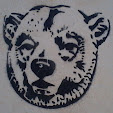I picked these up the other day and they
may or may not be 'new' to the hobby, I say "...may not..." as they might already be in the Plastic Warrior [link] magazine
'Special' edition on hollow-cast to plastic mouldings which was issued a few
years ago now. My copy is in storage and I intended to pick another up from the
Editor the other day but plans changed so I'm still in the dark as to their
position in 'the cannon'.
On the left in both shots is what seems to be
a new (third plastic) version of the Charbens
Household Cavalryman (here given a Horse Guards treatment - No. 291 in metal) while the right-hand
figure is a Crescent US style infantryman
with bugle, although in Joplin's 'Great Book' (see; Mr 'Emsworth Library' chap,
now you know why I needed it!)* they are just described as Khaki Infantry with
this one coded FC92 by Crescent in metal, and here given a
rather wacky paint-job!
The metal originals in The Great Book of Hollow-cast Figures by Norman Joplin
(photographed in low-resolution and at deliberately distorting angles for
obvious reasons), this shows the pre-war version of the bugler, post war he was
re-issued with a green helmet or paler fatigues.
The Household Cavalryman would get two further
versions in plastic, a similar copy of this one but with a larger thinner base,
and then a more obviously re-cut one on a heavy ovoid base, both however taking
the pose as here with the awkward holding of the sword out to the side with a
straight arm - try it! You did, didn't you? You just made a right-hand turn
signal, don't worry, so did I and I've done it before!
The Charbens
collection is so small it has its own box - which is in storage - so they were
missed out when we looked at the other Household Cavalry, what; six or seven
years ago? So we will look at them again - all three versions together -
another day, but I have picked-up a few more mounted figures (in the
storage-lot there are black, white and brown plastic with various saddle-cloths
including orange) as a size'er.
This chap (black one) came in with a bag of
odds and sods from a charity shop about six weeks ago, and would appear to be
the Cherilea (all the British 'C's
today!) hollow-cast moulding (No. 6/11), of interest as in plastic they
produced the two over-scale examples in the lower shot - the new one can 'play'
being a bantam!
Again I say 'would appear' as in Joplin's
book a black hen is photographed against a black background and seems to have a
slightly thinner neck and different tail, but the only other close one is a Barratt's hen which is more of a U-shape
without the flat back. Or/also the neck may have needed thickening to inject
plastic effectively?
The real curate's egg of this bunch; I
assume he's Charbens, he matches the
style of their other farm animals, and in particular; the [other] rearing foal,
upon-which this one seems to have been based, but with the back in the air. I
can't find the pose in any of the hollow-cast books or plastic resources and
Dave Scrivener didn't know of it?
I have one in what looks to be good factory
paint and one tatty, chewed one which may have been painted, maybe not, there's
no residue anywhere? The back legs look similar to the Charbens wagon horse but the front legs seem to have been carved out of the mould tool by a 16-year old on day one of a Youth Training Course!
I would be interested in anything else on this sculpt.
-------------------------------------------------
With regard to Plastic-from-hollow-cast
generally I was musing with Paul Morehead a while back on the possibility that
while we know some moulds ended-up elsewhere, might some of them have been
issued by the parent companies of the lead figures, perhaps as an initial
toe-in-the-water testing of the likely plastics market?
It would make sense to purchase a small
single-shot hand press (for a few hundred pounds?) and run a few figures off,
distributing to maybe a dozen or so local corner shops and newsagents (of which
there were a plethora in the 1950's) in the streets near the factory, on
sale-or-return or gifted (for feedback), before investing the vast amounts
needed to obtain an automated machine . . . or two!
*It'll be back with you in May, we've just
been given a four week extension on all books as the renovation has over-run -
sorry!








No comments:
Post a Comment